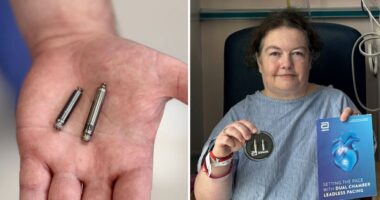Millions of Brits don’t know how to perform CPR, a charity has warned as it urged more people to learn the skill that can be the ‘difference between life and death’.
Just 43 per cent of people know how to give chest compressions to someone who has suffered a cardiac arrest, according to a poll by the British Heart Foundation.
More than 30,000 cardiac arrests — when the heart suddenly stops pumping blood around the body — occur outside of hospitals every year.
Dr Charmaine Griffiths, chief executive of the BHF, said: ‘Every moment matters when someone has a cardiac arrest.
‘Being able to step in and perform CPR could be the difference between life and death.

If the person is not breathing, or not breathing normally, call 999 and ask someone to find a defibrillator

To start chest compressions, knell next to the victim and place the heel of one hand on the centre of their chest. Place the other hand on top of the first and interlock your fingers

Cardiac arrest happens when there is an electrical problem in the heart, interrupting a normal heartbeat. It is different to a heart attack, which occurs when one of the coronary arteries become blocked — cutting off the heart’s blood supply. A heart attack can lead to cardiac arrest, however
‘A cardiac arrest can affect anyone, at any time, so we want as many people to learn CPR as possible.’
The survey of 2,002 over-16s, conducted by Censuswide, revealed that nine in 10 people recognised the importance of knowing CPR.
However, only 40 per cent could select the correct first step of the process.
Gen Z (aged 12 to 26) were more likely to be better trained, with 67 per cent knowing how to perform CPR.
The BHF has urged people to use its RevivR online tool, which takes just 15 minutes and teaches people how to recognise signs of cardiac arrest and perform CPR.
‘Not enough of us are confident and ready to use this skill,’ Dr Griffiths added.
‘With our tool RevivR, all you need to learn how to save a life is a spare 15 minutes, a phone and a cushion. Give it a try during your next coffee or lunch break — it could help you save a life, a loved one.’
Although it’s sometimes mistaken for a heart attack, a cardiac arrest is different.
A heart attack happens when blood supply to the heart muscle is cut off, often due to a clot. The heart continues to pump blood and a person will usually be conscious.
A cardiac arrest is when a person’s heart stops pumping blood around their body and they stop breathing normally. Sufferers collapse and will be unconscious, unresponsive and either not breathing properly or not breathing at all.
Step 1
If an adult appears unconscious, gently shake their shoulders and loudly ask if they are okay.
Step 2
If the person is not breathing, or not breathing normally, ask someone to call 999 and to find a public access defibrillator (PAD).
Call 999 yourself if no one is around. Call handlers will give instructions on how to perform CPR.
Step 3
Start chest compressions.
Kneel next to the victim and place the heel of one hand on the centre of their chest. Place the other hand on top of the first and interlock your fingers.
Keep your arms straight and use the heel of the hand to push down firmly between the breastbone — around 5 to 6cm — and release.

Keep your arms straight and use the heel of the hand to push down firmly between the breastbone — around 5 to 6cm — and release. Do this at a rate of 100 to 120 chest compressions per minute — around two per second
Do this at a rate of 100 to 120 chest compressions per minute — around two per second.
Songs including Stayin’ Alive by the Bee Gees, Eye of the Tiger by Survivor and Wannabe by the Spice Girls all have 100 to 120 beats per minute, so medics recommend thinking of these songs while performing CPR.
Step 4
Keep performing chest compressions until 999 crews arrive on the scene and take over, or the person starts to regain consciousness — by coughing, opening their eyes, speaking or breathing normally.
If someone is nearby, it can be performed in turns.
Step 5
If a defibrillator is found, turn it on and follow its instructions.
The machine will detect whether a shock is needed. Some of the gadgets will shock without prompt, while others will advise if a shock needs to be pushed to deliver the shock.
Rescue Breaths
While delivering chest compressions, give rescue breaths if you’re comfortable to do so.
The British Heart Foundation says CPR without mouth-to-mouth is still very effective at keeping the heart pumping.
To give rescue breaths, tilt the person’s head back gently and lift their chin up with two fingers.
Pinch their nose. Seal your mouth over theirs and blow hard for one second. Do this twice.
Then pump the chest for 30 counts before giving another two rescue breaths.










